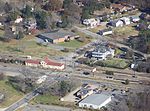Newport News Park
Newport News Park, in Newport News, Virginia, is the largest park in the system of municipal parks maintained by the Newport News Department of Parks, Recreation and Tourism. At 8,065 acres (32.63 km²), it is one of largest city-run parks in the United States, and offers a wide range of activities for residents and tourists alike. The park is in the northern part of the city of Newport News (13560 Jefferson Avenue, Newport News VA 23603), with its main entrance on Jefferson Avenue to the northwest of its intersection with Ft. Eustis Boulevard. Farther up Jefferson Avenue is the entrance to its campsite. To the northeast of the intersection, on Ft. Eustis Boulevard, is the secondary entrance at Old Stable Road, and farther up Ft. Eustis Boulevard is the main entrance for the Newport News Golf Club at Deer Run, which is on park grounds. The park shares a long border with the Colonial National Historical Park, and several of its biking and hiking trails cross into it.
Excerpt from the Wikipedia article Newport News Park (License: CC BY-SA 3.0, Authors).Newport News Park
Jefferson Avenue,
Geographical coordinates (GPS) Address Nearby Places Show on map
Geographical coordinates (GPS)
| Latitude | Longitude |
|---|---|
| N 37.179166666667 ° | E -76.551944444444 ° |
Address
Fire Station 4
Jefferson Avenue 13561
23603 , Lee Hall
Virginia, United States
Open on Google Maps






